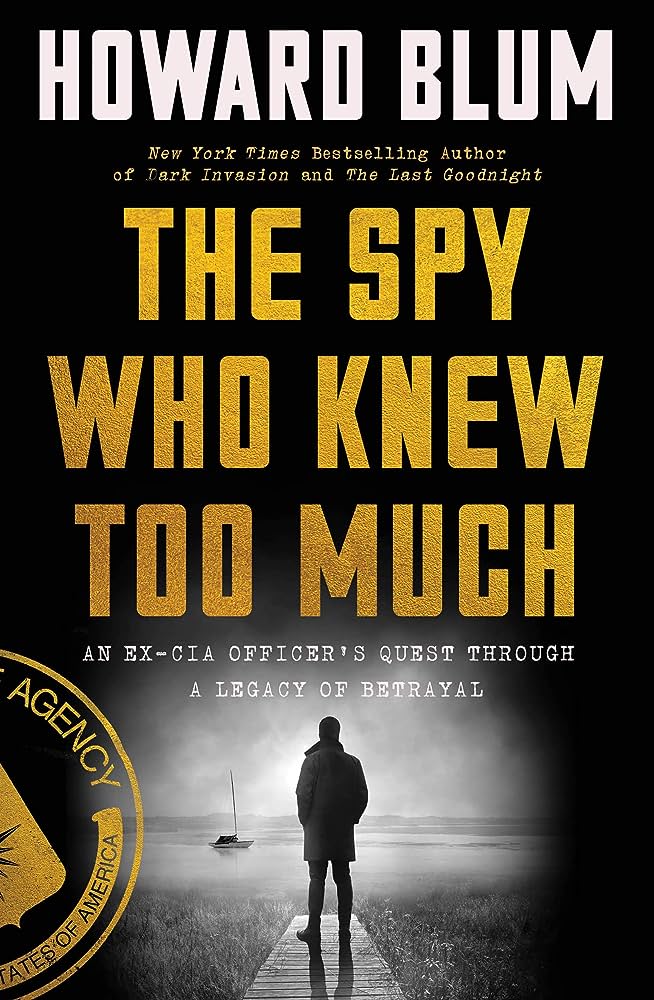
The Spy Who Knew Too Much by Howard Blum
What’s it About?
A retired spy gets back into the game to solve a perplexing case—and reconcile with his daughter, a CIA officer who married into the very family that derailed his own CIA career — in this true-life tale.
Readers may be convinced Howard Blum has concocted an eye-popping, nail-biting, edge-of-your-seat thriller before realizing it is a remarkable work of non-fiction history. Step aside James Bond to make way for Tennent “Pete” Bagley, a retired CIA agent with secrets of the Cold War to reveal. The Spy Who Knew Too Much(Harper),subtitled An Ex-CIA Officer’s Quest through a Legacy of Betrayal, now available in paperback,questions the competency, efficacy, integrity, and perspicacity of the Central Intelligence Agency.
The impression made indicates there was sparse communication between departments, a general lack of common sense and little actually accomplished in the field of intelligence gathering. There was a growing suspicion the agency’s objectives devolved into an outrageously expensive boondoggle with its direction and leadership changing as if wind-driven each time a new Director was appointed.
It suggested the agency had grown to be an overly large bureaucracy with too much fat and not enough fact-finding garnished with a lot of finger-pointing. This may have been Mr. Bagley’s implication but is truly not meant to disparage the dedicated, hard-working field operatives who risk their lives on a daily basis with honorable service and devotion to our country.
CIA Origins and Enemy Spies
Much has been written about the origins of the CIA from the Office of Strategic Services (OSS) that formed as an agency of the Joint Chiefs of Staff to coordinate military espionage during WWII. It began officially on June 13, 1942 and dissolved on September 20, 1945, under the leadership of Medal of Honor winner Major General William Joseph “Wild Bill” Donovan.
The purpose was to coordinate espionage activities for all branches of the United States Armed Forces in order to protect the troops and secure victory. Methods included many forms of clandestine activities including propaganda, behind-the-lines espionage, infiltration and work with resistance groups in occupied countries.
These approaches of utilizing photographs, electronic surveillance and ever-increasing technological advances continued with the advent of the Cold War and the creation in 1947 of the Central Intelligence Agency. The best and the brightest, especially those adept with foreign language skills, were and continue to be recruited from military and diplomatic services as well as colleges and universities.
The Spy Who Knew Too Much contains enough Russian KGB and Eastern European operatives, agents, double agents, genuine and faux defectors who are really Cold War enemy spies that it sometimes feels like you are reading a 20th century version of War and Peace. It would be enough to confuse Tolstoy. Fortunately, Howard Blum provides an essential guide with the “Cast of Characters” listed in the beginning of this gripping book which is a fresh take on a familiar true story.
The Story of Pete Bagley and a KGB Mole
The author unravels a complex real spy tale while pursuing the personal mission of redemption of a highly decorated CIA agent whose work and career had been discredited. Pete Bagley was a Princeton graduate from a family that was US Navy true blue. Impaired eyesight prevented him from following in his father’s and two brothers’ footsteps in attending the US Naval Academy in Annapolis, MD. All three had risen to the rank of four-star Admiral; no mean feat! Additionally, one uncle served as the Secretary of the Navy in WWI and another became a Fleet Admiral during WWII.
Bagley served honorably in the Marines, joined the CIA in 1949, and eventually earned a doctorate during his 22-year tenure with the agency. Handling defectors and spies in Clandestine Services, he attained the rank of Chief of Soviet bloc counterintelligence and was ostensibly on the fast track to become CIA Director.
Pete Bagley had been a risk-taking field operative behind the Iron Curtain in Europe long before the fall of the Berlin Wall and knew only too well the inherent dangers in fieldwork. He was far from being a mere Langley desk jockey. For years he sensed there was an American mole in the CIA supplying intelligence to the KGB; a treasonous betrayal of both country and the invaluable Soviet operatives working for the benefit of the USA. Four of these agents who had been providing crucial information were executed or assassinated, crippling the established pipeline while leaving families and friends bereft.
Pete Bagley began by attempting to identify the connections between a Russian defector and the American mole with the agency. He strongly suspected agent Yuri Nosenko had arrived with KGB contrived credentials and a thoroughly memorized script while remaining very much in the employ of Mother Russia. Despite repeated grilling, polygraph tests revealing inconsistencies, and imprisonment, Nosenko would not break or reveal the truth.
Bagley was convinced the information provided to the CIA by this supposed renegade Russian was a ruse to cover up the existence of a high-ranking mole within. His investigations led to destructive infighting, power struggles and internal disputes and a brief supposition by some that Bagley himself might be the mole. Reassigned in 1967 as the Brussels Station Chief and retiring in early 1972, he spent the remainder of his life in Belgium where he continued to conduct research, lecture, and write.
Curiously, in 1978, former long-time CIA officer John Paisley vanished. His sloop had run aground off the Chesapeake Bay and contained both evidence of a struggle and classified documents. A few days later, a decomposed body, wrapped in chains, surfaced, was identified as Paisley and the death was ruled a suicide. Unfortunately, the body in the water was 4 inches shorter and 40 pounds lighter than the real John Paisley whose fingerprints had been “lost” in CIA files.
It took several decades for Pete Bagley to confirm his own theories but his family was certain he rested easier when he passed away at 88 of natural causes. A peaceful death is never a sure thing, especially so in the world of international espionage.
Author Howard Blum is a former New York Times journalist, twice nominated for a Pulitzer Prize for investigative reporting. He has written several notable best-selling nonfiction books and one novel. Although not without controversy, it is certain The Spy Who Knew Too Much is an exciting read.

Publish Date: June 6, 2023
Genre: Historical, Nonfiction, Politics
Author: Howard Blum
Page Count: 352 pages
Publisher: Harper Paperbacks
ISBN: 9780063054226






























:quality(85):upscale()/2025/05/06/835/n/1922564/8e601b95681a5cf04194c6.14070357_.png)

:quality(85):upscale()/2025/05/05/100/n/1922564/33582ae7681964cb0d40c8.72464171_.png)



![ABYSMAL RITES – “Restoring The Primordial Order” [Heavy Sludge] ABYSMAL RITES – “Restoring The Primordial Order” [Heavy Sludge]](https://horrornews.net/wp-content/uploads/2025/04/WHD581-600x330.jpg)